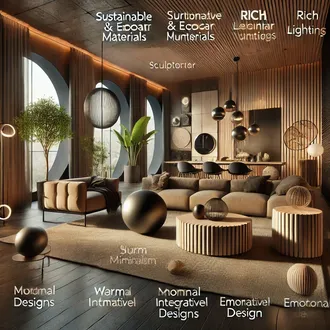Transcription The furniture
Furniture is the fundamental element within the interior spaces; determining what furniture will be needed and how to distribute it in the spaces according to the function it will fulfill and the client's needs, is one of the first and most important tasks faced by interior decorators.
To help the client to select the furniture for a room, decorators must know the criteria to be taken into account for its selection, as well as the advantages and disadvantages offered by the materials used in its manufacture.
Main aspects to take into account for the selection of furniture for a room
Functionality: This is the most important criterion for the selection of one, several or all the elements of the furniture of a room. To furnish a space, the decorator together with the client must determine which furniture is essential in an area to cover the daily needs of all the users of the space, with an adequate level of comfort.
The decorator cannot fall into the cliché that the kitchen has a cupboard, a table, four chairs and so on, but must make the client think if it is feasible to put the table with four chairs, if only two people live in the house and never eat breakfast or lunch in the kitchen.
Style: In addition to making the furniture functional, the decorator must ensure that it contributes to creating a visual setting in the room that pleases the client and is consistent with their tastes, their personality and the social environment in which they live. To select the right style, the decorator must know what materials, shapes, colors, texture, scale of the pieces and spatial organization of the furniture the client prefers. He should avoid by all means that the client's choice is totally subordinated to fashion or to recommendations from outsiders.
Scale and proportion: It is very important to select furniture that is appropriate in size and proportion to the space in which it will be located. It is possible that a kitchen cabinet is very beautiful and is made with the best wood; but if it is so big that when it is placed, it occupies twice as much space as it should, it should not be selected. When selecting the furniture, it is necessary to be rigorous with the sketch where the dimensions of the premises and the furniture properly distributed in the space are shown.
Feasibility: When selecting furniture we must take into account that the characteristics of the different materials used in its manufacture make them more suitable in certain conditions. For example: plywood is not feasible to use in furniture that has to be washed frequently, since the contact with water accelerates its deterioration.
Economy: A total budget should be established for the furniture, taking into account the minimum and maximum value of each of the pieces in order not to waste time in the selection. An element that should not be forgotten in this aspect is the durability index of the furniture; it would not be economical to buy very nice and cheap furniture if it has to be renewed quickly due to deterioration.
Main furniture materials
Furniture can be constructed using wood, plastic, metal or other artificial materials. Each material gives the furniture certain practical and aesthetic qualities that must be taken into account by the decorator when selecting or recommending a particular piece to the client.
Advantages and disadvantages of wood furniture.
Advantages:
- Wooden furniture is sturdy, strong, highly durable and never goes out of fashion.
- They can bring very high decorative values to spaces.
- Its finishes can be very versatile: they range from various natural forms of presentation - natural, rustic, polished - to those highly treated with lacquers, varnishes and various colors.
- Their maintenance turns out to be very simple, besides they can be repaired or restored to the splendor of the first day.
Disadvantages:
furniture furniture




